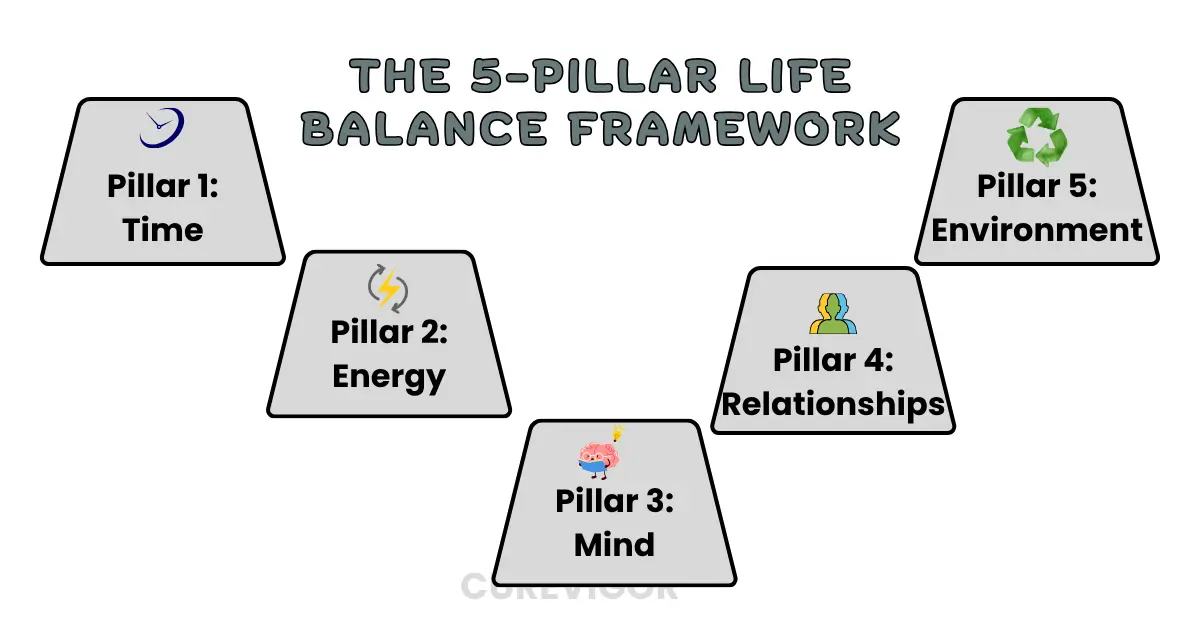Find out how science supports life balance. Assess your stress, set boundaries, and build energizing routines. Free 7-Day Balance Checklist inside!
Thank you for reading this post, don't forget to subscribe!In a world where busyness is worn like a badge of honor, finding a sense of balance can feel like an impossible dream. But it isn’t. True life balance isn’t about splitting your time evenly between work, family, and personal care.
It’s about creating harmony among the things that matter most to you. When you strike that balance, everything changes—your energy, focus, relationships, and overall well-being all improve.
This ultimate guide to life balance will help you understand what it means, recognize the signs of imbalance, and apply proven strategies to regain control of your time, mind, and energy.

Life Balance Guide: Proven Steps to a Calmer, More Energized You
Modern life runs at full speed, leaving little room to breathe. According to a recent RescueTime study, the average professional checks their phone over 50 times a day and spends more than 3 hours in meetings daily.
The result? Rising burnout, chronic fatigue, and stress levels that sap creativity and joy.
If this sounds familiar, you’re not alone. But there’s good news: life balance isn’t a myth. By the end of this guide, you’ll have a 9-step, research-backed life-balance plan to reset your energy, redefine your priorities, and create a calmer, more energized routine. Plus, you can grab a free 7-Day Life Balance Checklist to put it all into action.
Understanding Life Balance
Definition: What Is Life Balance?
Life balance refers to the state of equilibrium between different aspects of life—work, relationships, personal well-being, and leisure. It’s the art of managing responsibilities without sacrificing your mental health or happiness.
Achieving life balance doesn’t mean every day looks perfect. Instead, it’s about being flexible and intentional. Some days will lean heavily toward work, while others may focus on rest or connection. The goal is to maintain overall harmony, not perfection.
Importance: Why Life Balance Matters

Achieving a sense of balance in your life is essential for your physical health, emotional stability, and long-term productivity. Without it, even the most successful achievements can feel empty. Here’s why it matters:
- Improved Mental Health: Balanced living reduces anxiety and stress. You’re less likely to experience burnout when your life has space for rest and recovery.
- Better Physical Health: Chronic stress can lead to fatigue, poor sleep, and even illness. Balance helps maintain energy and vitality.
- Enhanced Productivity: When you’re rested and centered, your focus sharpens, and you accomplish more in less time.
- Stronger Relationships: Being present with loved ones deepens connection and trust.
- Greater Fulfillment: Life balance helps you align your actions with your values, fostering a sense of purpose and contentment.
In short, life balance is the foundation for sustainable success and happiness.
What Exactly Is Life Balance?
Life balance is a dynamic state of harmony among the major areas of your life—work, health, relationships, and self-care. It’s about thriving in multiple dimensions without feeling stretched too thin.
Life Balance vs. Work-Life Balance
| Aspect | Life Balance | Work–Life Balance |
| Focus | Holistic (work, personal, emotional) | Primarily work vs. home |
| Goal | Harmony across priorities | Equal division of time |
| Mindset | Adaptive and fluid | Often rigid or unrealistic |
While work-life balance tips are helpful, true life balance expands the lens to include emotional, physical, and spiritual well-being.
The Myth of Perfect Equilibrium
Balance doesn’t mean perfection. Life flows through seasons—times of focus, growth, rest, or change. A balanced person adapts to these rhythms rather than forcing symmetry every day.
Signs of Imbalance
Even the most disciplined individuals can fall out of balance. Recognizing early warning signs helps you correct course before things spiral out of control.
1. Stress and Anxiety
Feeling constantly overwhelmed, anxious, or unable to relax is one of the first indicators of imbalance. When you’re juggling too much, your mind and body remain in a state of high alert. Over time, this chronic stress leads to exhaustion, irritability, and decreased resilience.
2. Burnout
Burnout is more than tiredness—it’s emotional and physical depletion caused by prolonged stress. Symptoms include:
- Persistent fatigue
- Loss of motivation
- Cynicism toward work or relationships
- Reduced performance and creativity
Burnout can sneak up on anyone, especially high achievers who push past warning signs rather than address them.
3. Neglecting Self-Care
When life feels overwhelming, self-care is often the first thing to go. Skipping exercise, eating poorly, losing sleep, or neglecting hobbies are clear signs that balance is off.
Ignoring personal needs only deepens the imbalance and can impact your long-term health.
If these signs sound familiar, don’t panic. The good news is that the imbalance is reversible. With mindful adjustments, you can restore harmony and energy to your life.
Strategies for Achieving Life Balance
Finding life balance requires conscious choices and consistent habits. These practical strategies can help you regain control and stay grounded.
1. Set Boundaries
Establishing clear boundaries is one of the most effective ways to protect your energy and mental health. Boundaries help separate your work from your personal life and ensure you have time for yourself.
Practical Tips:
- Designate specific work hours—and stick to them.
- Turn off work notifications after hours.
- Communicate your availability clearly to colleagues and loved ones.
- Learn to decline requests that don’t align with your priorities.
Setting boundaries isn’t selfish; it’s an act of self-respect. It teaches others how to treat your time and space.
2. Prioritize Self-Care
Self-care isn’t indulgence—it’s maintenance. You can’t pour from an empty cup. Investing in your well-being allows you to show up fully for everything else in life.
Ideas for Self-Care:
- Exercise: Regular movement boosts mood, energy, and focus.
- Nutrition: Eat balanced meals that sustain your body and mind.
- Sleep: Prioritize 7–8 hours of quality sleep each night.
- Mindfulness: Practice meditation, deep breathing, or journaling to stay grounded.
- Joyful Activities: Schedule time for hobbies, nature, or creative outlets.
Self-care should be as non-negotiable as work meetings. The more consistent you are, the stronger your resilience becomes.
3. Manage Time Effectively
Time management is the backbone of life balance. Without it, even the best intentions fall apart. The goal isn’t to cram more tasks into your day—it’s to use your time intentionally.
Time-Management Techniques:
- Prioritize Tasks: Focus on high-impact activities using the Eisenhower Matrix (urgent vs. important tasks).
- Set Realistic Goals: Break big goals into manageable steps.
- Use Time Blocks: Schedule focused work periods and short breaks to stay productive.
- Avoid Multitasking: Concentrate on one task at a time for better efficiency.
- Delegate: Don’t try to do everything yourself.
By mastering your time, you free up mental bandwidth for creativity, relationships, and self-care.
4. Nurture Relationships
Strong relationships are essential to emotional well-being and life satisfaction. Building a support network can buffer stress and provide perspective when things get tough.
Ways to Strengthen Relationships:
- Prioritize face-to-face time with loved ones.
- Practice active listening—truly hear what others say without interrupting.
- Express gratitude regularly.
- Be honest about your needs and feelings.
Human connection is one of life’s greatest sources of balance. When you feel supported and valued, challenges become easier to navigate.
Why Life Balance Matters
A well-balanced life enhances health, happiness, and productivity. Here’s what the research shows:
- Lower Stress: Chronic imbalance raises cortisol levels, leading to anxiety and poor sleep (Mayo Clinic).
- Better Focus: People who rest and recharge achieve up to 20% higher productivity (Harvard Business Review).
- More Energy: Balanced routines stabilize blood sugar and reduce afternoon slumps.
- Stronger Relationships: Present, engaged people build trust and connection.
Employees with high balance report 21% more engagement.
Tips for Maintaining Life Balance
Once you achieve a sense of equilibrium, the goal is to maintain it over time. These simple but powerful habits can help keep your life balanced, even when stress levels rise.
Practice Mindfulness
Mindfulness is the art of being present. It helps you slow down and observe your thoughts and emotions without judgment. This awareness reduces stress and helps you make better decisions.
How to Practice Mindfulness:
- Start with 5–10 minutes of meditation daily.
- Take mindful walks—notice your surroundings and breathing.
- Pause before reacting to stressful situations.
Mindfulness improves focus and emotional regulation, two pillars of life balance.
Learn to Say No
One of the biggest threats to balance is overcommitment. Saying yes to everything leads to exhaustion and resentment. Learning to say no respectfully is a form of self-preservation.
Try This: Before agreeing to something, ask:
- Does this align with my priorities?
- Do I have the time and energy for this?
- Will this commitment enhance or drain my well-being?
Every ‘no’ creates space for what truly matters.
Take Regular Breaks
Rest is not a reward; it’s a requirement. Short breaks during work improve focus, while longer breaks, such as weekends or vacations, rejuvenate your body and mind.
Break Strategies:
- Follow the 50/10 rule—work for 50 minutes, rest for 10.
- Step away from screens to refresh your mind.
- Take walks outside to reset your perspective.
Regular downtime prevents burnout and keeps your energy balanced.
Quick Self-Assessment: Are You Out of Balance?
2-Minute Quiz
Answer yes or no:
- I check emails or messages within 5 minutes of waking up.
- I skip meals or eat while multitasking.
- I feel guilty taking breaks.
- I can’t recall the last time I relaxed without my phone.
- I often feel tired even after sleeping.
- My personal goals are on hold.
- I say “yes” when I want to say “no.”
- I haven’t taken a full day off in weeks.
Interpret Your Score
- 0–2 Yes (Green): You’re managing balance well.
- 3–5 Yes (Yellow): Minor adjustments needed.
- 6–8 Yes (Red): High risk of burnout.
Download the full Life Balance Audit & Planner (PDF) to create your roadmap.
The 5-Pillar Life Balance Framework
| Pillar | Focus | Mini-Keyword | Quick Action |
| Time | Prioritization & scheduling | time management for life balance | Try time-blocking |
| Energy | Physical vitality | boost daily energy naturally | Take movement breaks |
| Mind | Stress & mindset | mindfulness for balance | 5-minute breathing |
| Relationships | Family & social health | strengthen relationships | Schedule a weekly coffee date |
| Environment | Physical & digital spaces | declutter for balance | Create a digital detox zone |

Pillar 1: Time
Balance starts with time awareness. Block your calendar for priorities and breaks. Use tools like Google Calendar or Notion to visualize commitments.
Pillar 2: Energy
Energy fuels focus. Move daily, eat real food, and protect your sleep. Even 10-minute walks can refresh your body and brain.
Pillar 3: Mind
Mindset shapes perception. Use meditation, journaling, or gratitude to stay grounded.
Pillar 4: Relationships
Invest in quality time with people who uplift you. Real conversations nourish emotional health.
Pillar 5: Environment
Your surroundings influence mood and clarity. Keep spaces tidy and reduce digital clutter.
The 9-Step Roadmap to Rebalance Your Life
- Identify Core Values – Define what truly matters.
- Set Non-Negotiables – Protect sleep, family, and rest.
- Perform a Time Audit – Track one week of activity.
- Trim & Delegate (80/20 Rule) – Focus on what drives results.
- Design AM & PM Routines – Create anchors for calm and consistency.
- Build Micro-Breaks – Move, breathe, or stretch every hour.
- Batch Tasks & Theme Days – Reduce context switching.
- Weekly Balance Review – Reflect, adjust, repeat.
- Celebrate & Iterate – Reward consistency, not perfection.
Get the free Routine Planner & 7-Day Challenge to apply these steps.
Tools & Techniques That Make Balance Stick
- Time-blocking apps: Trello, Sunsama
- Focus tools: Pomodoro (25/5), 52/17 rule
- Mindfulness: Headspace, Insight Timer
- Energy cues: Standing desks, stretch timers
Affiliate disclosure: Some links may be affiliate links—no extra cost to you.
Common Obstacles & How to Overcome Them
| Obstacle | Root Cause | Quick Fix | Deep Fix |
| “No Time” | Over-committed schedule | 15-minute start rule | Delegate or decline tasks |
| Guilt | People-pleasing | Use reframing mantra | Practice boundary scripts |
| Energy Slumps | Blood sugar dips | 10-min walk | Nutrition reset plan |
7-Day Life-Balance Kick-Start Challenge
| Day | Focus | Mini Action |
| 1 | Awareness | Complete the 2-minute quiz |
| 2 | Energy | Go for a 20-minute walk |
| 3 | Time | Try time-blocking your top 3 tasks |
| 4 | Mind | Meditate for 5 minutes |
| 5 | Relationships | Text or call someone you appreciate |
| 6 | Environment | Declutter your desk |
| 7 | Reflection | Journal your wins and lessons |
Building Long-Term Habits for Life Balance
Life balance isn’t a one-time fix—it’s an ongoing practice. Sustainable change comes from building small, consistent habits that align with your values.
Long-Term Strategies:
- Reflect Regularly: Check in with yourself weekly. Ask what’s working, what isn’t, and what needs adjustment.
- Stay Flexible: Life changes, and so will your priorities. Adapt your balance accordingly.
- Celebrate Progress: Recognize your wins—no matter how small. Progress fuels motivation.
- Seek Support: If maintaining balance feels challenging, talk to a coach, therapist, or trusted friend.
These habits ensure that your pursuit of balance becomes a lifestyle, not a phase.
How Life Balance Boosts Productivity and Well-Being
Contrary to popular belief, working harder doesn’t always lead to better results. A balanced life enhances productivity by prioritizing energy management over time management.
1. Balanced People Think Clearer
When you’re not running on fumes, decision-making becomes easier. You’re more focused, creative, and capable of solving problems efficiently.
2. Balance Increases Motivation
Rested, fulfilled individuals naturally feel more inspired and engaged. You don’t have to force productivity—it flows naturally.
3. Better Health Equals Better Work
When you prioritize sleep, nutrition, and exercise, your energy levels remain stable, and your work performance improves.
4. Emotional Stability Leads to Stronger Relationships
Balanced living nurtures patience, empathy, and effective communication—qualities that strengthen both personal and professional relationships.
Ultimately, life balance isn’t about doing less; rather, it’s about directing your effort toward what matters most. With clarity and energy in mind. Let’s address some common misconceptions:
Common Myths About Life Balance
Myth 1: Balance Means Equal Time for Everything
Not true. Balance isn’t about distributing hours evenly across life areas—it’s about aligning your time with your priorities.
Myth 2: You Can Achieve Perfect Balance
Perfection is unrealistic. Life will always ebb and flow. The goal is to stay centered amid change, not control every variable.
Myth 3: Balance Is a Luxury
Balance isn’t a privilege reserved for a few; it’s a necessity for everyone who wants to live well. Even small changes can make a big difference.
By addressing these common myths, you can develop a more compassionate, practical approach to achieving real balance in daily life. For further clarity, here are frequently asked questions to support your journey:
FAQs
Q. What is the 8-8-8 rule for work-life balance?
The 8-8-8 rule is a simple time management model that divides your day into three equal parts: 8 hours for work, 8 hours for personal time, and 8 hours for sleep.
It’s designed to create structure while protecting rest and recreation. While not every schedule fits this perfectly, the principle reminds us to maintain healthy boundaries between productivity, recovery, and self-care — the core of any effective life balance framework.
Q. What is a famous quote about balance in life?
One of the most quoted sayings about balance comes from Buddha: “In moderation lies the key to happiness.” Another timeless one is from Albert Einstein: “Life is like riding a bicycle. To keep your balance, you must keep moving.”
Both reflect the same truth — balance isn’t about perfection or stillness, but about consistent, mindful motion that keeps all parts of life in harmony.
Q. Is 40 hours a week a good work-life balance?
For many people, 40 hours a week represents a manageable full-time workload — but balance depends on how those hours are used and what happens outside of them.
If you’re working focused, meaningful hours and still have time for sleep, exercise, and relationships, 40 hours can absolutely support a healthy work-life balance. The key isn’t just time spent working — it’s how much energy and presence you have left for the rest of life.
Q. What is the 20-20-20 rule for work-life balance?
The 20-20-20 rule originally applies to eye health — every 20 minutes, look at something 20 feet away for 20 seconds. But in the context of life balance, it’s often adapted to encourage micro-breaks.
Every 20 minutes of focus, take a 20-second pause, and every 2 hours, step away for 20 minutes. These intentional pauses help reduce burnout, improve focus, and maintain sustainable productivity throughout the day.
Q. What is the 9-80 rule?
The 9-80 rule is a flexible work schedule model used by some organizations to enhance work-life balance. Employees work 80 hours over nine days — typically nine hours per day from Monday to Thursday and eight hours on one Friday — followed by a full Friday off the next week.
It allows for longer weekends without cutting productivity, giving people extra time to rest and recharge.
Q. How many hours a week does Elon Musk work?
Elon Musk is known for his intense work ethic, reportedly working 80 to 100 hours per week across his companies, like Tesla and SpaceX. While this schedule fuels rapid innovation, it’s far from a sustainable life balance model for most people.
Musk himself has admitted the toll it takes on health and relationships — proof that even high achievers need rest, boundaries, and recovery to maintain long-term effectiveness.
Conclusion
Achieving life balance is a journey—not a destination. It requires awareness, commitment, and continuous adjustment.
By understanding what balance means, recognizing signs of imbalance, and implementing proven strategies like setting boundaries, prioritizing self-care, managing time, and nurturing relationships, you can create a more harmonious and fulfilling life.
Remember: balance doesn’t come from doing everything; it comes from doing the right things with purpose and presence.
When you commit to living with balance, you unlock the secret to a calmer, more energized, and genuinely happier you.
Get more Life-Balance Tips.
You might like:


